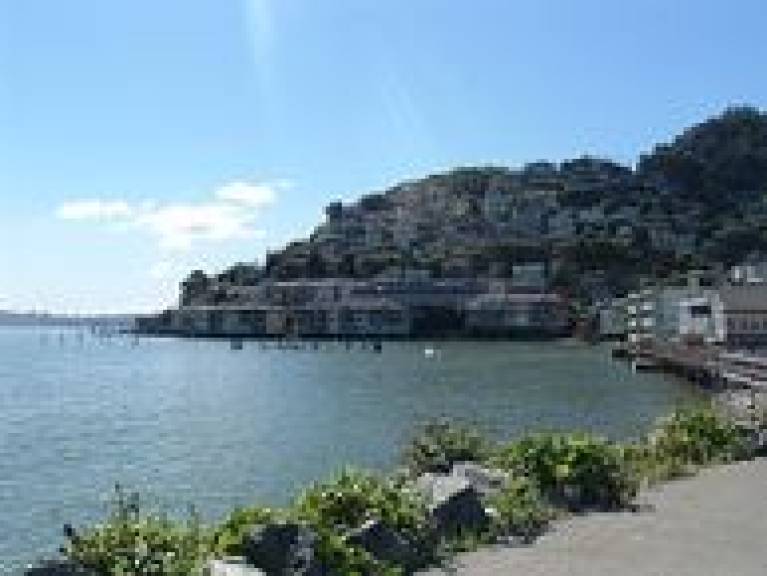Sausalito, CA Local Info
Airport Transportation

The charming waterfront town of Sausalito is a vibrant enclave renowned for its stunning views, artistic flair, and relaxed atmosphere. Just a short journey across the world-famous Golden Gate Bridge from San Francisco, Sausalito beckons visitors with its quaint streets, scenic vistas, and wealth of attractions.
Sausalito's main draw lies in its picturesque waterfront, where visitors can stroll along the bustling promenade, take in panoramic views of the bay, and marvel at the colorful houseboats that dot the shoreline. Art lovers will appreciate the town's thriving arts scene, with numerous galleries showcasing the work of local artists and artisans. Take time to explore the historic downtown area, with its charming boutiques, eclectic shops, and gourmet restaurants serving up delicious cuisine inspired by the flavors of the Bay Area.
For history buffs, attractions like the Bay Area Discovery Museum and the Marine Mammal Center offer fascinating insights into the region's natural and cultural heritage. Outdoor enthusiasts can embark on scenic hikes along the nearby Marin Headlands, or rent a bike and pedal along the scenic waterfront bike path. And of course, no visit to Sausalito would be complete without a leisurely ferry ride across the bay, offering stunning views of the San Francisco skyline and Alcatraz Island.
Getting to Sausalito from San Francisco is a breeze, with several transportation options available. The most popular method is via ferry, which departs regularly from the San Francisco Ferry Building and Pier 41. The ferry ride across the bay takes approximately 30 minutes and offers spectacular views of the Golden Gate Bridge and the city skyline. Alternatively, visitors can drive across the Golden Gate Bridge or take a bus from downtown San Francisco, with both options offering scenic routes along the bay.
For over three millennia, the Coast Miwok people thrived along the shores and hills of what is now Sausalito, leading a peaceful existence as hunter-gatherers. Their presence is still felt through remnants like shell mounds and burial sites scattered beneath the town's surface. However, in 1775, the arrival of the Spanish explorers aboard the San Carlos marked a pivotal moment, forever altering the Miwoks' tranquil way of life. From the small willow trees lining the stream banks, the area was dubbed "Saucito" (little willow), later evolving into "Saucelito," and finally "Sausalito".
In 1838, William Richardson, an English seaman married to the daughter of the Commandante of El Presidio, was granted a vast land parcel in what is now southern and western Marin County. Establishing his hacienda near present-day Caledonia Street, Richardson thrived with successful business ventures. Today, the body of water bordering Southern Marin County bears his name as Richardson's Bay.
Following Richardson's tenure, the Sausalito Land and Ferry Company purchased a significant portion of Rancho del Sausalito in 1868. They developed streets, subdivided waterfront and hill lots, and utilized the Princess steamer to transport prospective buyers from San Francisco. This period marked the transformation of Sausalito into a bustling transportation hub, attracting wealthy San Franciscans and upper-class British expatriates to the central hills.
Sausalito's cultural diversity flourished along Water Street, with Portuguese boatbuilders, Chinese shopkeepers, dairy ranchers, and more contributing to its vibrant mercantile culture. During Prohibition, Sausalito became a hub for bootlegging operations, serving as a conduit for rumrunners and hosting speakeasies and clandestine stills.
With the completion of the Golden Gate Bridge in 1937, Sausalito's transportation services dwindled, only to experience a resurgence during World War II with the construction of the Marinship shipyard. The influx of workers swelled the population and shaped Sausalito's identity as an artistic haven and bohemian enclave.
Following the war, Sausalito continued to attract artists, writers, musicians, and free spirits seeking refuge in its striking beauty and affordable rents. This influx of creativity fostered a vibrant arts scene, cementing Sausalito's reputation as an art colony and literary enclave. The return of passenger ferries in 1970 further solidified its status as a popular destination, attracting visitors from around the world to its harbors and marinas.
Today, Sausalito retains its diverse and dynamic character, embracing a blend of counter-culture, art, and innovation. Despite the many changes over the years, its spirit of diversity and vitality remains unaltered, ensuring that Sausalito will always be a place with a rich past and a promising future.